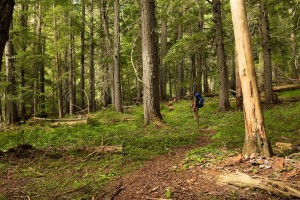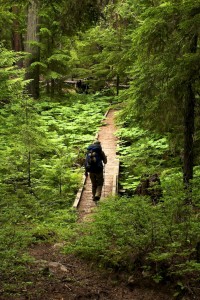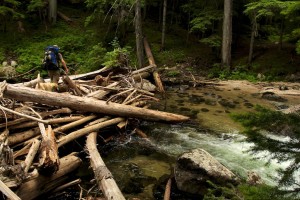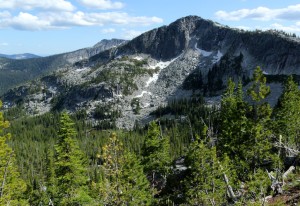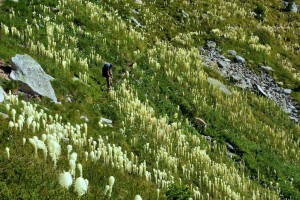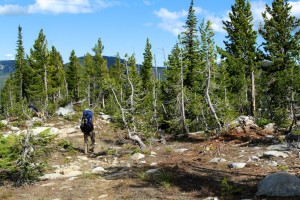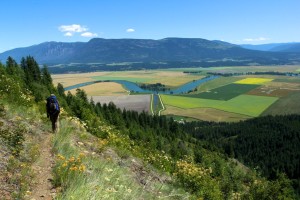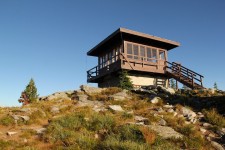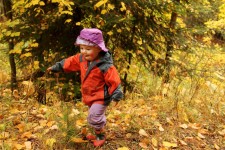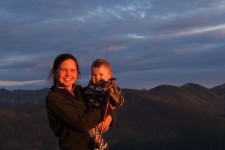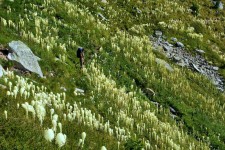Four miles and 52 leg-burning switchbacks to reach the trail junction below the ridge. A few more switchbacks through the transitioning forest and I’d be on Parker Ridge. Gaining the elevation from the bottom of Long Canyon to the top of Parker Ridge was no walk in the park but worth every step.
The longest, uninterrupted trail system in the Bonners Ferry Ranger District traverses Long Canyon and Parker Ridge for 33.8 miles of never-know-around-the corner surprises.
Edible surprises began before the Long Canyon trail even rounded into Long Canyon as tiny strawberries bursting with flavor dotted the trailside, followed by juicy huckleberries. The huckleberries turned greener as we progressed farther into the canyon with the plants just beginning to bloom on Parker Ridge.
Thanks to a trail crew, the trail was freshly sawn out which made hiking easy. In prior years, the trail crew had constructed boardwalks across the muddier sections of the canyon.
A log jam on Canyon Creek enabled a quick first creek crossing. The second and third creek crossings couldn’t be completed quickly enough in the near freezing water. Trading hiking shoes for sandals, the frigid water quickly numbed my feet as I tried to find steady footing without feeling in my feet. Stumbling onto the opposite bank, I waited for the excruciating pain to succumb.
Also leaving footprints on the beach of the second crossing was a large grizzly bear, luckily in the opposite direction we were hiking. Other animals left sign on the trail, including moose, deer, a coyote and a small black bear.
A mule deer even left tracks on the top of Parker Peak, the highest named peak in the American Selkirks at 7,691 feet according to the GPS (the highest is an unnamed ridge at 7,709 feet). Remnants of the old fire lookout also lay on the peak with a commanding view of the entire Selkirk range, Purcells and Cabinet Mountains. Clifty looked dwarfed and Hall Mountain seemed small.
The person manning the fire lookout enjoyed a view but I wouldn’t want to be there during a thunderstorm. Being on a peak also meant water wasn’t close at hand. The person probably had to hike down to Parker Lake (nearly two miles one-way) or melt snow from the ridges like we did while it lasted. Near the summit, someone long ago moved the boulders in a boulder field aside to create a trail bed for easier access to the summit. No small feat and probably done for the pack animals carrying the materials and supplies for the lookout built in 1939.The benchmark on the peak was placed in 1924 and no trail led to the summit at that time.
Rounding the corner after descending the peak, a hidden avalanche chute brimmed with blooming beargrass. Hundreds of blooms stood tall in the treeless swath below a nearly vertical granite slab and continued down to Parker Creek. Never had I seen so much beargrass in bloom. Beargrass bloomed on other portions of the trail, particularly along the switchbacks, but not in the same magnitude.
Also in surprising quantities before reaching Parker Peak were whitebark pine trees. More than just a lone whitebark pine here and there, the entire ridgeline was a whitebark pine forest of good-sized trees. After Parker Peak, alpine larch and spruce joined the whitebark pine forest, then lodgepole pine. Closer towards the valley, the forest turned to open lodgepole pine with huckleberry brush and blooming lupine.
A thousand feet below in Long Canyon, mature and old growth cedar and hemlock dominated. Undergrowth varied from moss to ferns and devil’s club. Transitioning through the different forest types and guessing what was coming next kept the trip full of surprises—including guessing the number of switchbacks to the ridge.

